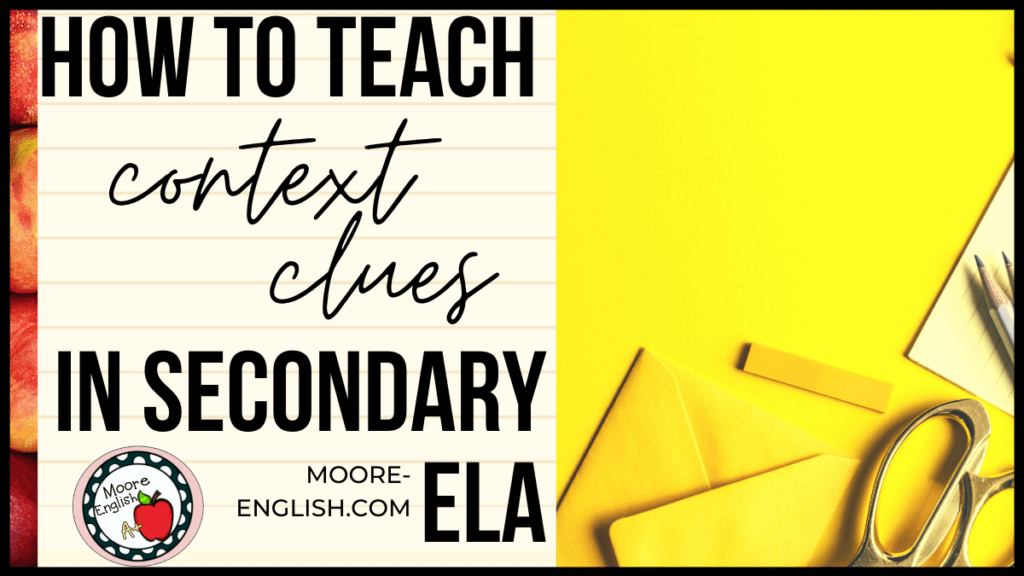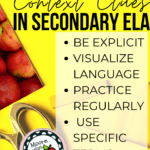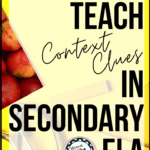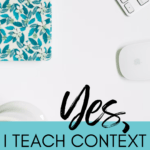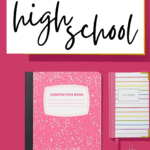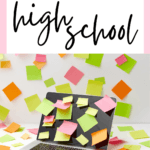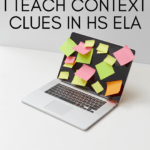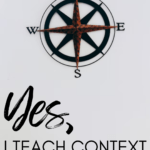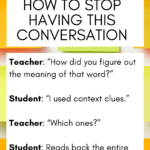Teacher: “How did you figure out the meaning of that word?”
Student: “I used context clues.”
Teacher: “Which ones?”
Student: Reads back the entire sentence.
This conversation makes me crazy. As a newer teacher, I was satisfied when my students used the words “context clues.” Looking back on this exchange, I realize that my students knew how to “play” school. They had picked up on (and probably been coached) to say phrases like “context clues.” But they hadn’t been given the tools to identify specific strategies and moves and, as a result, they were wrong as often as they were right. So I set out to make sure my students had specific strategies for determining the meaning of unknown words.
This post this post may contain affiliate links. Please read the Terms of Use.
Why Context Clues Matter
We know that context clues are part of the Common Core. And we know that vocabulary questions are probably a part of standardized testing. But why should students have specific strategies?
- Vocabulary acquisition is one of the 5 Pillars of Literacy. Being able to read fluently without having to stop to Google a definition aids in reading comprehension.
- Context clues exist outside of reading, and job interviews and movie theaters are not appropriate environments for stopping to look up a definition.
- Using context clues happens at the intersection of inference and close reading. Being able to navigate different aspects of comprehension provides readers with the greatest opportunity to make meaning.
- Determining the meaning of unknown words crosses disciplines. Using context clues is a skill that transfers to math, science, social studies–unknown and challenging language is everywhere!
Direct Instruction
By the time students get to high school, they usually know the phrase “context clues.” But when pressed, students can’t usually identify specific strategies or even the steps involved in determining the meaning of unknown words. For this reason, I start introducing context clues by asking students what thinking action is involved in determining the meaning of unknown words.
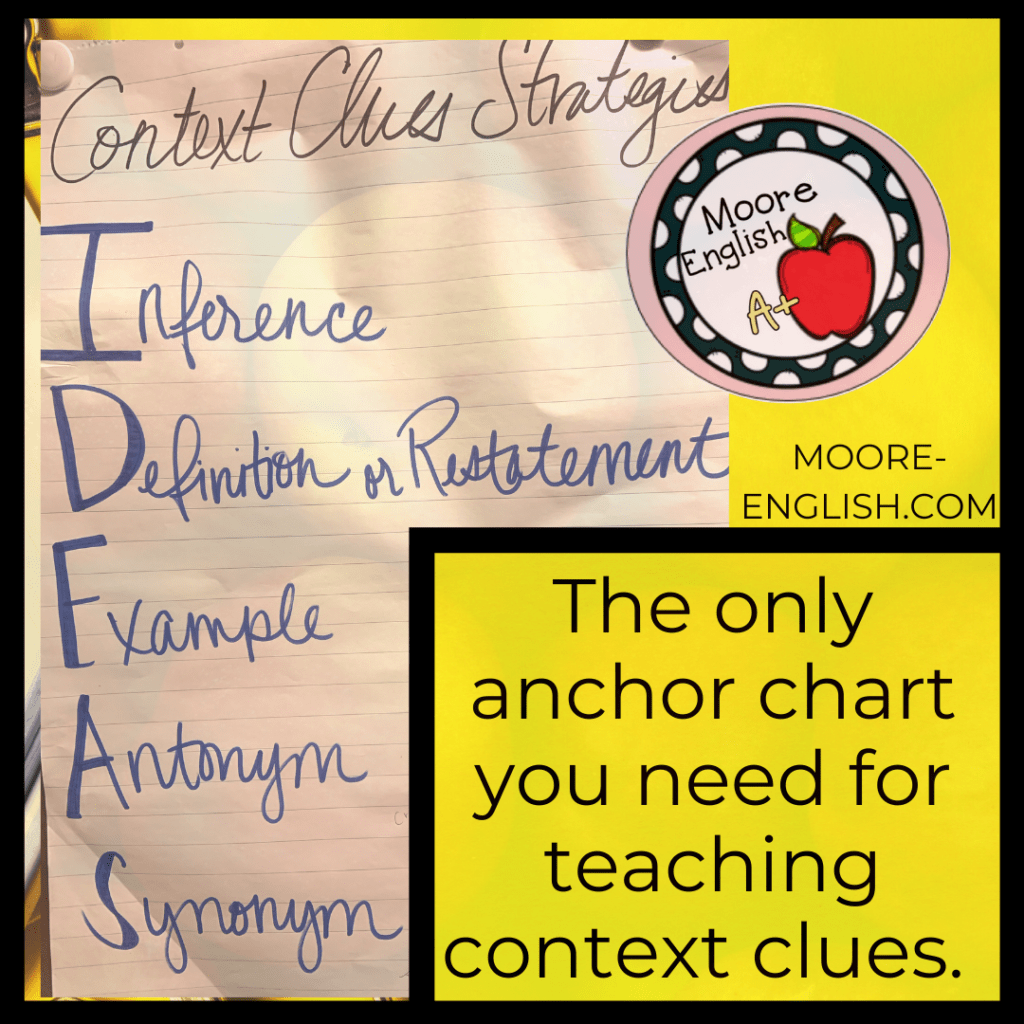
After a think-pair-share, students usually determine that using context clues requires the skill of inference. From here, I tell students that we are going to learn all the different kinds of inferences involved in using context clues. Then I introduce students to the IDEAS acronym (see anchor chart). I first heard about this acronym from a colleague, but a quick spin through Pinterest reveals even more examples. (You can check out my Vocabulary Instruction board here). I begin to make the anchor chart on the board. And students make their own chart in their notebooks. I write IDEAS on our chart paper. Students let me know the “I” is inference. I don’t let them guess any of the other letters because this can lead to confusion.
Then, I show this video from Study.com. (It’s actually one of my favorite 10 Videos for Secondary ELA.) As students watch the video, they fill out the rest of their anchor chart and learn the other types of specific context clues (definition, restatement, example, synonym, antonym, and substitution). Then, in an effort to model and practice, we choose a word from our class reading and run it through all parts of IDEAS. In the past, I’ve used the words meticulous, empathy, and idealistic for this activity to great success.
Visualizing Language
Once our anchor chart is finished, we hang it on the chart and reference it all year. But visualizing goes beyond anchor charts, so here are a few other ways to help students visualize context clues.
Annotation: When students are reading content texts, they encounter all kinds of unknown words. For this reason, students can add a specific annotation mark for using context clues to determine meaning. Each of my classes has its own idiosyncratic close reading and annotation “key.” But my favorite is for students to circle the unknown word and then draw an arrow back to the word(s) that helped them determine its meaning. This visualization strategy transfers across contents, texts, and works well for test prep!
Word Profiles: The Frayer Model is a well-known method for helping students investigate a word. One of the most powerful aspects of the Frayer Model is visualization. Once students know a word’s meaning, they illustrate the word. Students can great really creative with their visual representations. And drawings are a great way for students to internalize content. I’ve also found that my students enjoy sharing their drawings and getting ideas from one another. With my students’ specific needs in mind, I adapted the Frayer Model. You can get my Word Profile graphic organizer for free here.
Context Clues Practice
As with most skills, the best way to get better at using these strategies is to practice. Just as importantly, we have to keep asking students to identify specific moves they made when determining the meaning of unknown words. Push them to point to specific words, phrases, and images that clued them in to a word’s meaning.

Because these strategies are so important, my sophomores do one context-clues question everyday starting in the second month of school. We do a new question Monday-Thursday. Then students choose one word from the week to put in a Word Profile. Because I wanted students to be using vocabulary from our class readings, I chose the words ahead of time and put them on chart paper (see picture). I flip the chart at the beginning of each day (or assign a student to flip the chart). So coming in to check out the daily question is just part of our procedure for entering the room and getting starting. I’ve put together some of the context-clues questions my students use for To Kill a Mockingbird and Things Fall Apart and have also put together Volumes 1 and 2 of Shakespeare context clues.
Students think about the question independently while I greet students at the door. Then, while I take attendance, students pair-share with a partner. After eliminating two answers as a class, we rotate which partnership will share their answer. As part of sharing, the students identify which specific strategies they used.
Similarly, when students come across a vocabulary question on a quiz or a test, there is always a secondary question asking for a description of the strategy.
This system of explicitly teaching context-clues strategies, visualizing language, and regularly practicing has really improved my students’ ability to determine the meaning of unknown words. Now, when I ask a student how they determined a word’s meaning, rarely does a student read me back the entire sentence.

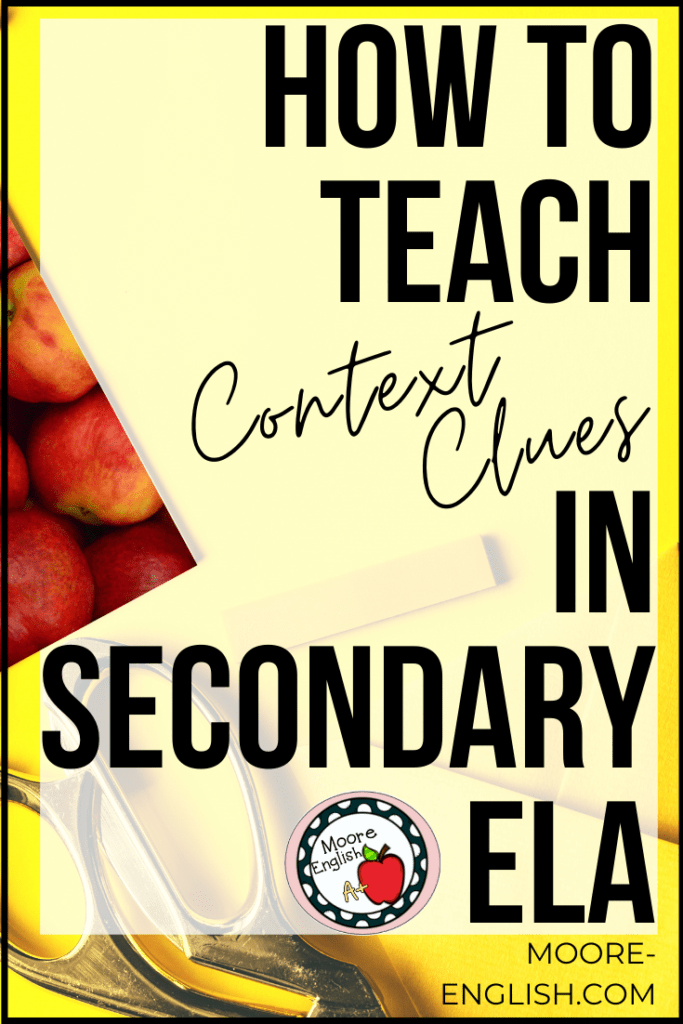
Photo by Joanna Kosinska on Unsplash

